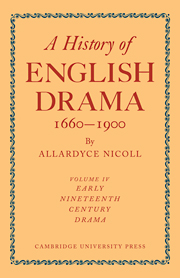Book contents
- Frontmatter
- PREFACE
- Contents
- PART I
- Chapter One THE THEATRE
- Chapter Two THE DRAMATIC CONDITIONS OF THE AGE
- Chapter Three THE ILLEGITIMATE DRAMA
- Chapter Four THE LEGITIMATE DRAMA
- Chapter Five THE STILL-BORN DRAMA
- Chapter Six CONCLUSION
- SUPPLEMENTARY NOTES
- Appendix A THE THEATRES, 1800–1850
- PART II
- SUPPLEMENTARY NÓTES TO THE HAND-LIST OF PLAYS 1800–1850
- INDEX OF PERSONS AND SUBJECTS
Appendix A - THE THEATRES, 1800–1850
Published online by Cambridge University Press: 07 October 2011
- Frontmatter
- PREFACE
- Contents
- PART I
- Chapter One THE THEATRE
- Chapter Two THE DRAMATIC CONDITIONS OF THE AGE
- Chapter Three THE ILLEGITIMATE DRAMA
- Chapter Four THE LEGITIMATE DRAMA
- Chapter Five THE STILL-BORN DRAMA
- Chapter Six CONCLUSION
- SUPPLEMENTARY NOTES
- Appendix A THE THEATRES, 1800–1850
- PART II
- SUPPLEMENTARY NÓTES TO THE HAND-LIST OF PLAYS 1800–1850
- INDEX OF PERSONS AND SUBJECTS
Summary
London and Environs
In this list I have included all the theatres and houses of entertainment known to me between the opening and the middle of the century. This account, of course, could have been extended to great length by the enumeration of managers and the occupancy of actors, but such detail appeared not to have importance enough for inclusion here. I have restricted myself, therefore, to the outstanding facts, which I have endeavoured to make as accurate as possible. It will be observed that change of name was common in this period, and I have thought it best to tabulate the theatres separately under their various titles rather than group these titles under a single heading. Full cross-references indicate the history of any single building during the half-century.
Almost all these theatres are new. In 1800 only nine theatres were in regular use: Drury Lane, Covent Garden, the Opera House in the Haymarket, the Theatre Royal, Haymarket, Sadler's Wells, the Royal Amphitheatre, the Royal Circus, the Royaltý and the Sans Souci. Of these, practically all were rebuilt during this era, and, as will be realised, many fresh playhouses rose in rivalry to them in many districts of London.
The Academic Theatre (Leicester-place, Leicester-square). Under this name the Sans Souci was opened in 1806 as a Dramatic Academy.
The Adelphi (Strand) [Adel.]. As the Adelphi, the old Sans Pareil was opened on Saturday, Oct. 23, 1819.
- Type
- Chapter
- Information
- A History of English Drama 1660-1900 , pp. 222 - 244Publisher: Cambridge University PressPrint publication year: 1955



